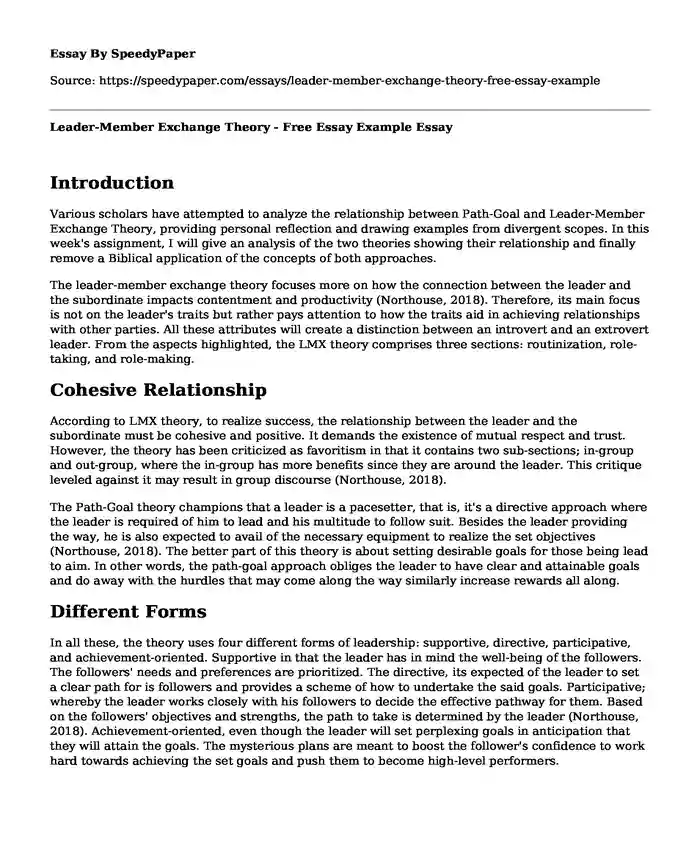
| Type of paper: | Essay |
| Categories: | Leadership analysis |
| Pages: | 3 |
| Wordcount: | 607 words |
Introduction
Various scholars have attempted to analyze the relationship between Path-Goal and Leader-Member Exchange Theory, providing personal reflection and drawing examples from divergent scopes. In this week's assignment, I will give an analysis of the two theories showing their relationship and finally remove a Biblical application of the concepts of both approaches.
The leader-member exchange theory focuses more on how the connection between the leader and the subordinate impacts contentment and productivity (Northouse, 2018). Therefore, its main focus is not on the leader's traits but rather pays attention to how the traits aid in achieving relationships with other parties. All these attributes will create a distinction between an introvert and an extrovert leader. From the aspects highlighted, the LMX theory comprises three sections: routinization, role-taking, and role-making.
Cohesive Relationship
According to LMX theory, to realize success, the relationship between the leader and the subordinate must be cohesive and positive. It demands the existence of mutual respect and trust. However, the theory has been criticized as favoritism in that it contains two sub-sections; in-group and out-group, where the in-group has more benefits since they are around the leader. This critique leveled against it may result in group discourse (Northouse, 2018).
The Path-Goal theory champions that a leader is a pacesetter, that is, it's a directive approach where the leader is required of him to lead and his multitude to follow suit. Besides the leader providing the way, he is also expected to avail of the necessary equipment to realize the set objectives (Northouse, 2018). The better part of this theory is about setting desirable goals for those being lead to aim. In other words, the path-goal approach obliges the leader to have clear and attainable goals and do away with the hurdles that may come along the way similarly increase rewards all along.
Different Forms
In all these, the theory uses four different forms of leadership: supportive, directive, participative, and achievement-oriented. Supportive in that the leader has in mind the well-being of the followers. The followers' needs and preferences are prioritized. The directive, its expected of the leader to set a clear path for is followers and provides a scheme of how to undertake the said goals. Participative; whereby the leader works closely with his followers to decide the effective pathway for them. Based on the followers' objectives and strengths, the path to take is determined by the leader (Northouse, 2018). Achievement-oriented, even though the leader will set perplexing goals in anticipation that they will attain the goals. The mysterious plans are meant to boost the follower's confidence to work hard towards achieving the set goals and push them to become high-level performers.
Conclusion
According to the theory critiques, the theory assumes the existence of only one method for the followers to attain success, thus providing limited alternatives. Additionally, the followers are obligated to the path that their leader decides.
Both theories have a relatively unique relationship; exemplifying the views using Merida's text (Exalting Jesus in 1 & 2 Kings) and other Biblical contextualization will provide a comprehensive understanding concept of both approaches.
The reasons the Israelites were banished from their ancestral land were because they failed to listen to the prophets and worshipped idols, and as a result, they received blessings and curses. Similar circumstance which Moses was faced with when he decided to disobey God's command.
References
Merida, T. (2015). Exalting Jesus in 1 & 2 Kings. B&H Publishing Group.
Murphy, S. E., & Ensher, E. A. (1999). The effects of leader and subordinate characteristics in the development of leader–member exchange quality 1. Journal of Applied Social Psychology, 29(7), 1371-1394.
Northouse, P. G. (2018). Leadership: Theory and practice. Sage publications.
Cite this page
Leader-Member Exchange Theory - Free Essay Example. (2023, Nov 25). Retrieved from https://speedypaper.com/essays/leader-member-exchange-theory-free-essay-example
Request Removal
If you are the original author of this essay and no longer wish to have it published on the SpeedyPaper website, please click below to request its removal:
- Free Essay on Leadership Styles within the FMCG Industry in Malaysia
- Free Essay Containing a Personal Leadership Development Plan
- Essay Sample: My Evaluation for Future Leadership
- Free Essay Example - Mentoring and Coaching Reflection
- Paper Example. Managing Cultures
- Public Leadership: An Inclusive Task for All - Essay Sample
- Essay Example - Characteristics of Amazon Market Structure
Popular categories




